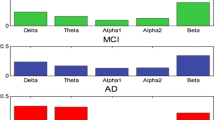Abstract
Electroencephalography (EEG) and Magneto-encephalography (MEG) are important tools for assessing brain activity that are being developed scientifically. EEG enables better clinical and healthcare services to meet the rising need for the early diagnosis of brain disease at cheap prices. In this paper, EEG and MEG signals are used as an input to detect brain cancer and strokes in its early stages. A single-trial channel data (STD), averaged channel data (ACT), and time–frequency data organisation of the channel data is required for the EEG/MEG signal projection from the channel to the source space (TFD). The signals are pre-processed using discrete wavelet transform to adaptive time–frequency resolution of analysis on nonstationary signals. Then, the signals are given as an input to the Fast Fourier Transform to get subsets of typical in-class “invariant” coefficients from wavelet coefficients (time–frequency information). Finally, the multi-class SVM is employed for classifying normal, cancer, and stroke cases using EEG and MEG signals. A quantitative analysis of the proposed method is conducted using parameters like accuracy, specificity, and precision. The proposed Dual signal classification model achieved higher accuracy is 92.59%. According to the proposed Dual signal classification model, Bootstrap models, SVM, XGBoost, and Fast Fourier Transform improve the overall accuracy by 4.61%, 0.16%, 15.77%, and 9.63%, respectively.
Access this chapter
Tax calculation will be finalised at checkout
Purchases are for personal use only
Similar content being viewed by others
References
Thanaraj, K.P., Parvathavarthini, B., Tanik, U.J., Rajinikanth, V., Kadry, S., Kamalanand, K.: Implementation of deep neural networks to classify EEG signals using gramian angular summation field for epilepsy diagnosis. arXiv preprint arXiv:2003.04534 (2020)
Hazra, D., Byun, Y.: Brain tumor detection using skull stripping and U-Net architecture. Int. J. Mach. Learn. Comput. 10(2), 400–405 (2020)
Wang, F., Tian, Y.C., Zhang, X., Hu, F.: Detecting disorders of consciousness in brain injuries from EEG connectivity through machine learning. IEEE Trans. Emerg. Top. Comput. Intell. (2020)
Savadkoohi, M., Oladunni, T., Thompson, L.: A machine learning approach to epileptic seizure prediction using electroencephalogram (EEG) signal. Biocybern. Biomed. Eng. 40(3), 1328–1341 (2020)
Shaari, H., Kevrić, J., Jukić, S., Bešić, L., Jokić, D., Ahmed, N., Rajs, V.: Deep learning-based studies on pediatric brain tumors imaging: narrative review of techniques and challenges. Brain Sci. 11(6), 716 (2021)
Qureshi, A.A., Zhang, C., Zheng, R., Elmeligi, A.: Ischemic stroke detection using EEG signals. In: CASCON, pp. 301–308 (2018)
Bera, T.K.: A review on the medical applications of electroencephalography (EEG). In: 2021 Seventh International Conference on Bio Signals, Images, and Instrumentation (ICBSII), pp. 1–6. IEEE (2021)
Sawan, A., Awad, M., Qasrawi, R.: Machine learning-based approach for stroke classification using electroencephalogram (EEG) signals (2022)
McDermott, B., Elahi, A., Santorelli, A., O’Halloran, M., Avery, J., Porter, E.: Multi-frequency symmetry difference electrical impedance tomography with machine learning for human stroke diagnosis. Physiol. Meas. 41(7), 075010 (2020)
Choi, Y.A., Park, S., Jun, J.A., Ho, C.M.B., Pyo, C.S., Lee, H., Yu, J.: Machine-learning-based elderly stroke monitoring system using electroencephalography vital signals. Appl. Sci. 11(4), 1761 (2021)
Adhi, H.A., Wijaya, S.K., Badri, C., Rezal, M.: Automatic detection of ischemic stroke based on scaling exponent electroencephalogram using extreme learning machine. J. Phys. Conf. Ser. 820(1), 012005. IOP Publishing (2017)
Hassan, R., Hasan, S., Hasan, M.J., Jamader, M.R., Eisenberg, D., Pias, T.: Human attention recognition with machine learning from brain-EEG signals. In: 2020 IEEE 2nd Eurasia Conference on Biomedical Engineering, Healthcare and Sustainability (ECBIOS), pp. 16–19. IEEE (2020)
Author information
Authors and Affiliations
Corresponding author
Editor information
Editors and Affiliations
Rights and permissions
Copyright information
© 2023 The Author(s), under exclusive license to Springer Nature Singapore Pte Ltd.
About this paper
Cite this paper
Ahilan, A., Angel Sajani, J., Jasmine Gnana Malar, A., Muthu Kumar, B. (2023). Machine Learning-Based Brain Disease Classification Using EEG and MEG Signals. In: Bhateja, V., Yang, XS., Ferreira, M.C., Sengar, S.S., Travieso-Gonzalez, C.M. (eds) Evolution in Computational Intelligence. FICTA 2023. Smart Innovation, Systems and Technologies, vol 370. Springer, Singapore. https://doi.org/10.1007/978-981-99-6702-5_40
Download citation
DOI: https://doi.org/10.1007/978-981-99-6702-5_40
Published:
Publisher Name: Springer, Singapore
Print ISBN: 978-981-99-6701-8
Online ISBN: 978-981-99-6702-5
eBook Packages: Intelligent Technologies and RoboticsIntelligent Technologies and Robotics (R0)




